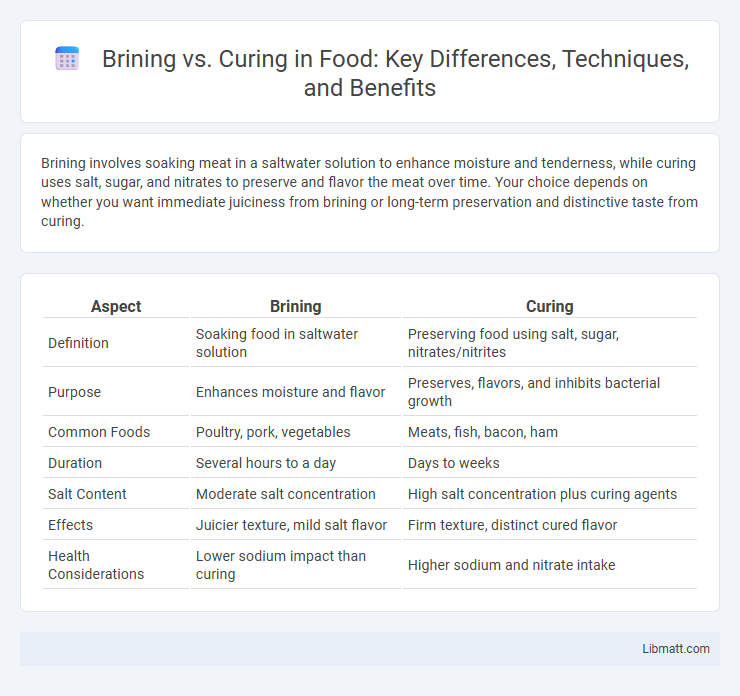Brining involves soaking meat in a saltwater solution to enhance moisture and tenderness, while curing uses salt, sugar, and nitrates to preserve and flavor the meat over time. Your choice depends on whether you want immediate juiciness from brining or long-term preservation and distinctive taste from curing.
Table of Comparison
| Aspect | Brining | Curing |
|---|---|---|
| Definition | Soaking food in saltwater solution | Preserving food using salt, sugar, nitrates/nitrites |
| Purpose | Enhances moisture and flavor | Preserves, flavors, and inhibits bacterial growth |
| Common Foods | Poultry, pork, vegetables | Meats, fish, bacon, ham |
| Duration | Several hours to a day | Days to weeks |
| Salt Content | Moderate salt concentration | High salt concentration plus curing agents |
| Effects | Juicier texture, mild salt flavor | Firm texture, distinct cured flavor |
| Health Considerations | Lower sodium impact than curing | Higher sodium and nitrate intake |
Introduction to Brining and Curing
Brining involves soaking meat in a saltwater solution to enhance moisture retention and tenderness, commonly used for poultry and pork. Curing refers to the preservation of meat through the application of salt, nitrates, or sugar, often combined with smoking or drying to develop distinct flavors and extend shelf life. Your choice between brining and curing depends on desired taste, texture, and preservation needs.
Key Differences Between Brining and Curing
Brining involves soaking food in a saltwater solution to enhance moisture retention and tenderness, while curing uses salt, sugar, nitrates, or nitrites to preserve and flavor meat over a longer period. Brining typically affects texture and juiciness by increasing water content, whereas curing chemically alters proteins to prevent bacterial growth and develop distinctive flavors. The primary distinction lies in brining's focus on moisture improvement versus curing's preservation and flavoring purpose.
Purpose and Benefits of Brining
Brining enhances meat's moisture retention by soaking it in a saltwater solution, resulting in juicier and more tender cooked products. The salt in the brine penetrates muscle fibers, improving flavor and texture while preventing dryness during cooking. This method also allows for the infusion of herbs and spices, creating complex taste profiles and extending shelf life.
Purpose and Benefits of Curing
Curing preserves meat by inhibiting bacterial growth through the use of salt, nitrates, or nitrites, enhancing both safety and shelf life. This method also intensifies flavor profiles and improves the texture of meats, making products like ham and bacon distinctively savory and tender. The extended preservation allows for versatile culinary applications and reduces spoilage, benefiting both producers and consumers.
Common Ingredients Used in Brining
Brining commonly involves water, salt, sugar, and various aromatics such as garlic, bay leaves, and peppercorns to enhance moisture retention and flavor in meats. The salt concentration typically ranges from 5% to 10%, which helps to break down muscle proteins and increase juiciness. Sometimes, herbs and spices like thyme, rosemary, and cloves are added to customize the taste profile during the brining process.
Common Ingredients Used in Curing
Curing commonly involves salt, sugar, nitrates, and nitrites to preserve and enhance the flavor of meats, preventing bacterial growth and adding a distinctive taste. Spices like garlic, black pepper, and bay leaves are frequently included to complement the basic curing agents. These ingredients work synergistically to ensure safety, texture, and depth of flavor in cured products such as bacon, ham, and jerky.
Methods and Techniques for Brining
Brining involves soaking meat, poultry, or seafood in a solution of salt and water, often supplemented with sugar, herbs, and spices, to enhance moisture retention and flavor. Common techniques include immersion brining, where the protein is fully submerged, and injection brining, which speeds up the process by directly injecting the solution into the meat. The salt concentration typically ranges from 5% to 10%, with precise timing varying based on the type and size of the food for optimal texture and juiciness.
Methods and Techniques for Curing
Curing techniques primarily involve the application of salt, sugar, nitrates, and sometimes smoke to preserve meats and enhance flavor, utilizing dry curing and wet curing methods. Dry curing entails rubbing the meat with a curing mix and storing it in controlled environments, while wet curing involves submerging meat in brine solutions containing curing agents. Variations such as injection curing and massaging accelerate the process in commercial settings, ensuring uniform distribution of curing compounds.
Food Safety Considerations
Brining uses a saltwater solution to enhance moisture and flavor while slowing bacterial growth, making it a safer method for preserving meats. Curing relies on salt, nitrates, or sugar to inhibit microbial activity and prevent spoilage, but improper curing can lead to harmful bacteria like botulism. Understanding the food safety considerations of brining versus curing helps you protect your health and ensure safe, delicious results.
Which Method to Choose: Brining or Curing?
Choosing between brining and curing depends on the desired texture, flavor, and preservation needs of the food. Brining is ideal for enhancing moisture and tenderness in meats like poultry, using a saltwater solution that penetrates quickly. Curing, with dry salt or curing agents, is preferred for long-term preservation and developing rich, intense flavors in products such as ham and bacon.
Brining vs Curing Infographic

 libmatt.com
libmatt.com